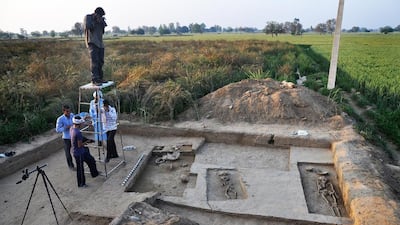NEW DELHI // When Niraj Rai travels to Pune on Wednesday to pick up DNA samples from 4,000-year-old human skeletons, he will set in motion a process that might resolve Indian history’s most fiercely debated question: Who were the ancient Indians?
So far, the archaeological remains of the Indus Valley civilisation, which flourished across north-western India and Pakistan between 3,300 and 1,700BC, have provided few clues about the people who lived there, their ethnic or racial background, the language they spoke, or the religion they followed.
Mr Rai, a geneticist at the Centre for Cellular and Molecular Biology (CCMB) in Hyderabad, will be working with samples from four Indus Valley skeletons that are now at Pune’s Deccan College, in its well-regarded archaeology department.
Until they were excavated in January and February, the human remains — two male, one female, and one child — lay in a cemetery not far from the village of Rakhigarhi, in Haryana, about 150 kilometres from Delhi.
Of the many known archaeological sites dating back to the Indus Valley Civilisation, Rakhigarhi is the largest.
Discovered in 1965, the settlement is spread over three to four square kilometres, and is thought to have been home to nearly 200,000 people. Excavations revealed a planned city, with roads nearly two metres wide, and brick-lined drains on either side. There were fire altars, gold foundries, and a large granary.
Archaeologists even found little toys, including a figurine resembling a dog on a leash.
Although skeletons have been found in Rakhigarhi in the past — 13 of them, in one dig between 1997 and 2000 — as well as in other Indus Valley sites, the four skeletons stored in Pune will be the first to undergo DNA extraction and analysis, Mr Rai said.
Due to humid conditions, skeletons found in Indus Valley Civilisation sites have invariably degraded more than those found in cold locations like the Himalayas, or hot, dry desert locations, said Vasant Shinde, the vice-chancellor of Deccan College and an archaeologist working at Rakhigarhi.
Additionally, "With earlier excavations, we perhaps made mistakes," Mr Shinde told The National.
“We put the skeletons on display, maybe for a month, so that people could come and see them. And in the process of excavation and display, they got contaminated with modern human DNA.”
At Rakhigarhi this year, archaeologists thus took extra precautions in excavating the skeletons, in a manner that preserve any DNA still on them.
“This time, we immediately wrapped each bone in foil, to avoid contamination and degradation,” Mr Shinde said. “We also collected the soil that would have been around the abdomen area of each skeleton, because the soil can be tested for the eggs of parasites that may have existed within the stomachs of these people.”
“We all have parasite eggs within us, because the food and water we ingest has some minimum contamination,” he said. “But they can tell us something about the diet of these people and their health.”
The four Rakhigarhi skeletons will also benefit from being the first Indus Valley skeletons to be unearthed after CCMB developed its own procedures to test skeletal DNA.
"Each country or region needs its own procedure to analyse ancient DNA, because the weather varies so much that DNA is preserved to different degrees and in different ways," Mr Rai told The National. "We developed our protocol, specific to Indian conditions, in 2009-10."
The facility has worked on other cases since its inception. The most notable example, Mr Rai said, was that of a set of 100 samples taken from human remains on the shores of the Roopkund Lake, high in the Himalayas.
The CCMB lab was able to show that the remains were most likely those of travellers from Iran who died during a hailstorm around 800AD.
Until this finding, speculation had it that the remains were of Tibetan monks or of soldiers from an invading army.
The uncontaminated DNA samples from the four Rakhigarhi skeletons, Mr Rai said, will first be “amplified” — a procedure to draw out genetic attributes of the humans from other “junk” bacterial DNA that might be present in the samples.
The sequenced DNA will be entered into a database that contains thousands of samples from across the world, as well as into CCMB’s own diverse database of 30,000 DNA sequences from Indian individuals.
The closest match from these databases to the Rakhigarhi samples will be a matter of immense interest, said Veena Mushrif Tripathi, another archaeologist at Deccan College.
For decades, scholars have hotly debated whether the residents of the Indus Valley Civilisation were “Indo-Aryans” — from a family speaking a branch of the larger Indo-European language — or whether they were other indigenous peoples, who were supplanted and absorbed over time by Indo-Aryan migrants from the west.
No conclusive proof has been presented on either side. Relics have been interpreted in multiple ways, and the civilisation’s “script” — symbols found on clay seals and pottery — has not yet been deciphered.
The Rakhigarhi samples will be compared to DNA from populations to the west of India, from other ancient Indian DNA, and from various modern Indian communities, Ms Tripathi said.
“This will be a considerable contribution to Indian history from the fields of archaeology and anthropology,” she said. “It could rewrite our identities altogether.”
ssubramanian@thenational.ae

